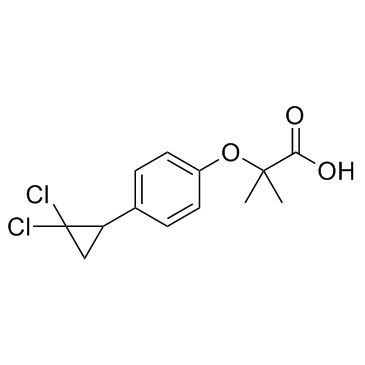52214-84-3
| Name | ciprofibrate |
|---|---|
| Synonyms |
2-[p-(2,2-Dichlorocyclopropyl)phenoxy]-2-methylpropanoic acid
Ciprofibrate 2-[p-(2,2-Dichlorocyclopropyl)phenoxy]-2-methylpropanoic acid,Ciprofibrate EINECS 257-744-6 MFCD00467135 2-(4-(2,2-Dichlorocyclopropyl)phenoxy)-2-methylpropanoic acid 2-[4-(2,2-Dichlorocyclopropyl)phenoxy]-2-methylpropionic Acid UNII:F8252JGO9S 2-[4-(2,2-dichlorocyclopropyl)phenoxy]-2-methylpropanoic acid |
| Description | Ciprofibrate is a peroxisome proliferator-activated receptor agonist.Target: PPARCiprofibrate is a hypolipidemic compound that can induce proliferation of peroxisomes in liver cells of rats. Known to be a PPARα (peroxisome proliferator-activated receptor α) agonist [1, 2]. |
|---|---|
| Related Catalog | |
| Target |
PPARα |
| References |
| Density | 1.4±0.1 g/cm3 |
|---|---|
| Boiling Point | 424.9±45.0 °C at 760 mmHg |
| Melting Point | 114 - 118ºC |
| Molecular Formula | C13H14Cl2O3 |
| Molecular Weight | 289.155 |
| Flash Point | 210.7±28.7 °C |
| Exact Mass | 288.032013 |
| PSA | 46.53000 |
| LogP | 2.87 |
| Vapour Pressure | 0.0±1.1 mmHg at 25°C |
| Index of Refraction | 1.579 |
| Storage condition | 2-8°C |
CHEMICAL IDENTIFICATION
HEALTH HAZARD DATAACUTE TOXICITY DATA
MUTATION DATA
|
| Symbol |

GHS08 |
|---|---|
| Signal Word | Danger |
| Hazard Statements | H350 |
| Precautionary Statements | P201-P280-P308 + P313 |
| Personal Protective Equipment | Eyeshields;full-face particle respirator type N100 (US);Gloves;respirator cartridge type N100 (US);type P1 (EN143) respirator filter;type P3 (EN 143) respirator cartridges |
| Hazard Codes | T:Toxic |
| Risk Phrases | R45 |
| Safety Phrases | S53-S22-S36/37/39-S45 |
| RIDADR | NONH for all modes of transport |
| WGK Germany | 3 |
| RTECS | UF0880000 |
| HS Code | 2918990090 |
|
~% 
52214-84-3 |
| Literature: Sterling Drug Inc. Patent: US3948973 A1, 1976 ; |
| Precursor 1 | |
|---|---|
| DownStream 0 | |
| HS Code | 2918990090 |
|---|---|
| Summary | 2918990090. other carboxylic acids with additional oxygen function and their anhydrides, halides, peroxides and peroxyacids; their halogenated, sulphonated, nitrated or nitrosated derivatives. VAT:17.0%. Tax rebate rate:13.0%. . MFN tariff:6.5%. General tariff:30.0% |

